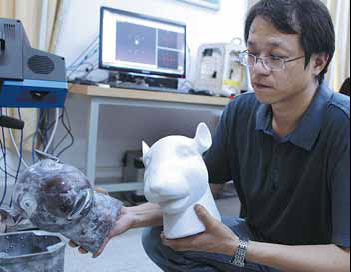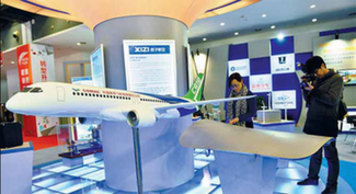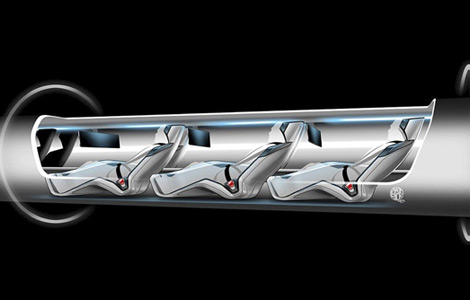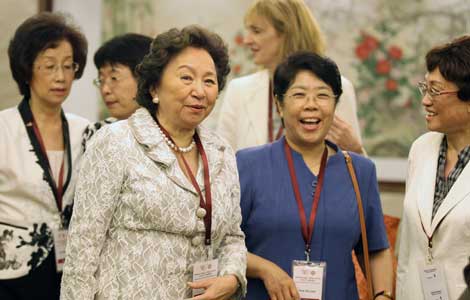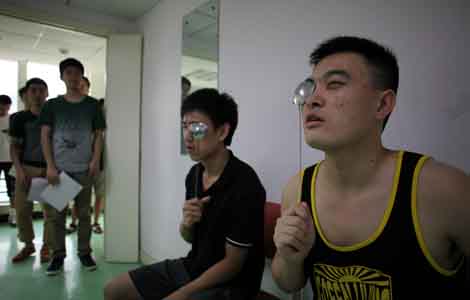3-D printing adds wings to aviation
Updated: 2013-08-13 07:26
By Cheng Yingqi (China Daily)
|
||||||||
|
Zhou Gang, a doctoral candidate in material science at Huazhong University of Science and Technology, holds an animal head sculpture in his right hand and a replica made through 3-D printing in his left. Photo by Guan Xin / China Daily |
|
Visitors examine a model of China's first domestically designed commercial aircraft, COMAC's C919, at an exhibition in Beijing. Scientists used 3-D printing technologies to design components for the plane, such as the example pictured below right. Da Wei / for China Daily |
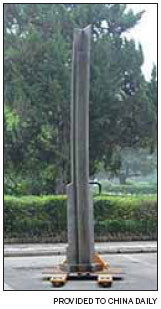
Special printers used to produce objects by following a computer blueprint in 'additive manufacturing', Cheng Yingqi reports.
Anew industrial process is taking off in the Chinese aviation industry as scientists and industrialists exploit its advantages in the research and manufacture of commercial and military aircraft.
Industry sources said 3-D printing technology has found its way into the production of titanium alloy airframes, landing gear and engine parts, such as turbine blades and disks.
On the C919, China's first domestically designed commercial aircraft, scientists used 3-D printing technologies to design the plane and are now actively exploring production techniques.
The C919 is a narrow-body airliner being built by the Commercial Aircraft Corporation of China.
Industry experts expect the plane, which will have seating for 158 to 174 passengers, to be China's answer to the Boeing 737 and the Airbus A320.
The 3-D design process means the aircraft may burn 12 to 15 percent less fuel than its foreign peers and could reduce operating costs by 10 percent.
In addition to the C919, 3-D printing technology has been used in the manufacture of parts for COMAC's Advanced Jet 21 regional jet, which has been making trial flights since 2009, according to the Beijing-based China Aviation News.
Xi'an Aircraft Industry (Group) Co has established a team to conduct research into the application of 3-D printing techniques in precision casting, which has helped accelerate the development cycle, the paper said.
Quick and inexpensive
Also called "additive manufacturing", the process uses special printers to produce a 3-D object by following a computer blueprint. Essentially, the digitized information is fed into a computer, which then controls printer nozzles and sprays layer upon layer of the raw material onto a manufacturing bed to produce a three-dimensional representation of the information. The materials are then fused to create the finished product.
While conventional techniques may take weeks to produce a single component, 3-D printing can complete the task much more quickly.
"With 3-D printing technology, you can produce sophisticated aviation industry components in just half the time and at half the expense of traditional manufacturing methods," said Lu Bingheng, a member of the Chinese Academy of Engineering and a leading light in the field of machinery manufacture and automation.
"As the C919 is still under development, the technology remains scientific exploration. More research should be conducted to ensure the quality of civil aircraft, and we should be able to design a full set of quality standards for the 3-D-printed parts before they are used in commercial applications," Lu said.
The C919 will make its maiden test flight at the end of 2015, according to reports, and Zhang Yanzhong, a member of the Chinese Academy of Engineering and also an advisor to the C919 program, told the China News Service that the aircraft has already attracted 380 orders from overseas.
In addition to its use on the C919, 3-D printing technology has been employed in the design of fighter jets, according to Sun Cong, the designer of the J15 fighter, who said the technique was used in the production of the plane's supporting structure.
"In the field of aviation applications for 3-D printing, China is making synchronous progress with the developed countries," said Lu. "This technology will be widely used in aviation worldwide, and will be a sharp competitive edge in the field," he predicted.
Wang Minghua, a professor at Beijing University of Aeronautics & Astronautics who specializes in material sciences, explained that Chinese research has already had a huge impact on the nascent technology.
"Although scientists in other countries know how to print smaller parts from titanium alloys, we made the technological breakthrough for larger components that can be used in planes," he said.
Wang and his team developed the methods and equipment that allow lasers to print 5-square-meter components made of titanium alloys, expensive materials whose high tensile strength and lightness make them perfect for use in the aviation industry.
Reduction of wastage
"Production of aircraft parts faster and cheaper with 3-D printing," according to Wang.
Traditionally, components are made by the process of injection molding, where liquid metal is forced into molds at high pressure and then left to cool. The drawback is that the molds have to be designed and made before the parts can be manufactured, which is costly and wastes materials. "For example, the production of a component might involve the use of three metric tons of steel, but after machining, the part may weigh just 144 kilograms," said Wang.
Printing the parts is a more efficient method, because it avoids the time-consuming process of making and assembling the molds and then refining the cast components into the finished article.
Traditionally, very large components have been made in piecemeal fashion. The parts are assembled and welded into the finished product at the post-production stage - an approach that can have ramifications in terms of strength and durability. "The strength of a welded part is surely not as good as an integral, one-formed printed component," commented Wang.
However, he admitted that 3-D printing is not necessarily more efficient in every circumstance. "The larger and the more sophisticated the component, the more competitive advantages 3-D printing has," he said.
The technique also has applications in a wide range of spheres. For example, military experts are pinning their hopes on a "revolution in logistical support" that may be brought about by 3-D printing.
In the future, armies may be able to print medicines and other supplies, even basic foodstuffs, on the battlefield, instead of waiting for deliveries from their supply lines, according to a report authored by two military experts in the Science and Technology Daily.
In addition to the military applications, the technology can also be widely used in high-end manufacturing, including the design of automobiles and home appliances, according to Lu.
"This new 3-D printing is an efficient tool to help improve manufacturing levels and, as such, can play a major role in upgrading China's high-end industries," he said.
Contact the author at chengyingqi@chinadaily.com.cn
(China Daily USA 08/13/2013 page7)
Most Viewed
Editor's Picks
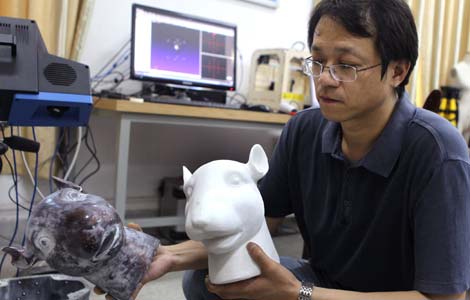
|

|
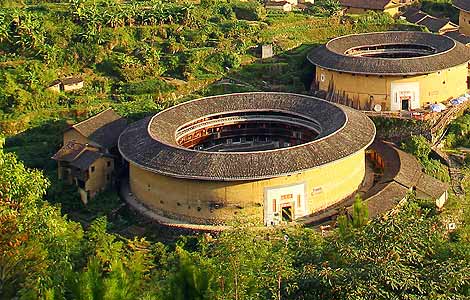
|

|
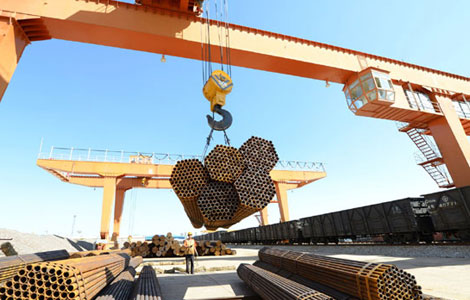
|

|
Today's Top News
Academy will turn a Hilton into a dorm for Chinese
Brazil puts off bidding on bullet train
US to examine intelligence collection methods
Economists cautious about China's recovery
Consumers losing confidence in Fonterra
Surge in raw material imports 'positive'
Research funds spread across the globe
Reps gear up for TPP round 19
US Weekly

|

|
